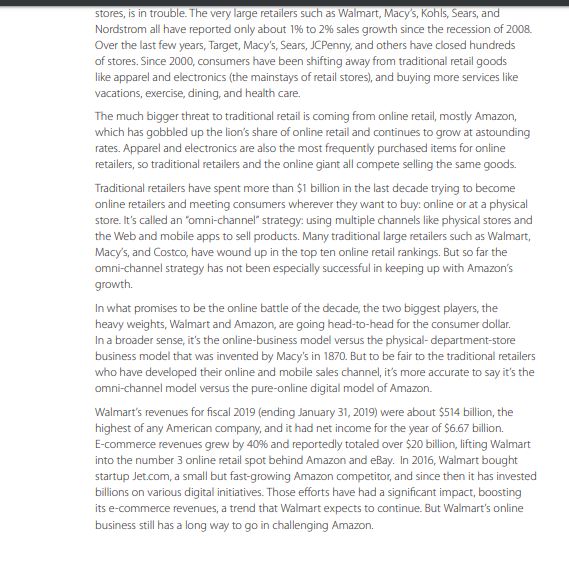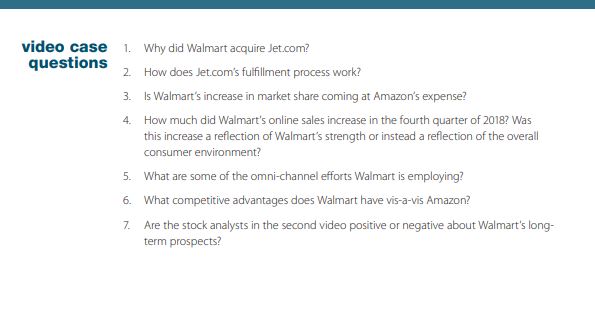Question
Traditional retail in the United States, the kind you find at the malls, and urban department stores, is in trouble. The very large retailers such
Traditional retail in the United States, the kind you find at the malls, and urban department stores, is in trouble. The very large retailers such as Walmart, Macy's, Kohls, Sears, and Nordstrom all have reported only about 1% to 2% sales growth since the recession of 2008. Over the last few years, Target, Macy's, Sears, JCPenny, and others have closed hundreds of stores. Since 2000, consumers have been shifting away from traditional retail goods like apparel and electronics (the mainstays of retail stores), and buying more services like vacations, exercise, dining, and health care. The much bigger threat to traditional retail is coming from online retail, mostly Amazon, which has gobbled up the lion's share of online retail and continues to grow at astounding rates. Apparel and electronics are also the most frequently purchased items for online retailers, so traditional retailers and the online giant all compete selling the same goods. Traditional retailers have spent more than $1 billion in the last decade trying to become online retailers and meeting consumers wherever they want to buy: online or at a physical store. It's called an "omni-channel" strategy: using multiple channels like physical stores and the Web and mobile apps to sell products. Many traditional large retailers such as Walmart, Macy's, and Costco, have wound up in the top ten online retail rankings. But so far the omni-channel strategy has not been especially successful in keeping up with Amazon's growth. In what promises to be the online battle of the decade, the two biggest players, the heavy weights, Walmart and Amazon, are going head-to-head for the consumer dollar. In a broader sense, it's the online-business model versus the physical- department-store business model that was invented by Macy's in 1870. But to be fair to the traditional retailers who have developed their online and mobile sales channel, it's more accurate to say it's the omni-channel model versus the pure-online digital model of Amazon. Walmart's revenues for fiscal 2019 (ending January 31, 2019) were about $514 billion, the highest of any American company, and it had net income for the year of $6.67 billion. E-commerce revenues grew by 40% and reportedly totaled over $20 billion, lifting Walmart into the number 3 online retail spot behind Amazon and eBay. In 2016, Walmart bought startup Jet.com, a small but fast-growing Amazon competitor, and since then it has invested billions on various digital initiatives. Those efforts have had a significant impact, boosting its e-commerce revenues, a trend that Walmart expects to continue. But Walmart's online business still has a long way to go in challenging Amazon.
Question:


Step by Step Solution
There are 3 Steps involved in it
Step: 1

Get Instant Access to Expert-Tailored Solutions
See step-by-step solutions with expert insights and AI powered tools for academic success
Step: 2

Step: 3

Ace Your Homework with AI
Get the answers you need in no time with our AI-driven, step-by-step assistance
Get Started


